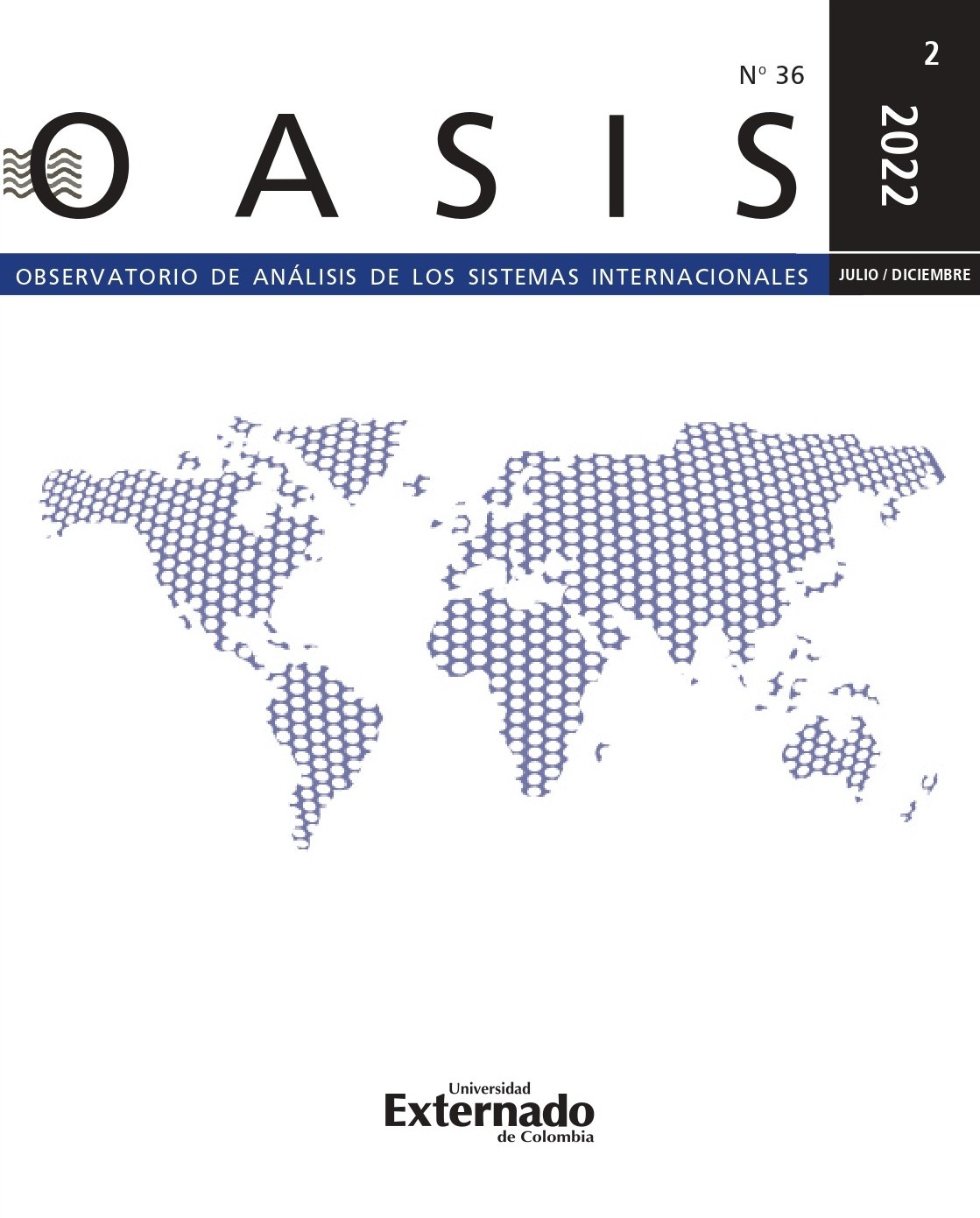Genocidio del siglo XXI: el caso de los Rohingya
Genocide of the 21st Century: The Case of the Rohingya
Contenido principal del artículo
Resumen
La presente investigación se propone describir, explicar y analizar el proceso de genocidio en Myanmar en contra de la comunidad rohingya. Los usos de la religión, las redes sociales y la identidad sirvieron como herramientas para justificar la violencia, eliminar al enemigo y ocultar la verdadera causa de la ofensiva militar contra la comunidad musulmana en 2017. Asimismo, el conflicto histórico entre las comunidades internas y el efecto de la apertura democrática y económica del país encaminaron a la sociedad de Myanmar hacia la condena de los rohingyas y a adquirir un lugar como actor en el genocidio. De esta manera, la sociedad legitimó al gobierno militar en las operaciones militares de 2017 que forzaron el desplazamiento de más de 700.000 rohingyas quienes, sumados a los más de 200.000 que ya habían migrado entre 2012 y 2015, se encuentran sin Estado ni derechos en el campo de refugiados más grande del mundo en Bangladesh.
Palabras clave
Descargas
Detalles del artículo
Referencias / Ver
Al Jazeera Investigative Unit (2015). Genocide Agenda: Documents presented as evidence. Al Jazeera. https://www.aljazeera.com/features/2015/10/28/genocideagenda-documents-presented-as-evidence/.
Anwary, A. (2018). Atrocities against the Rohingya Community of Myanmar. Indian Journal of Asian Affairs, 31 (1/2), 91-102. www.jstor.org/stable/26608825
Asamblea General de las Naciones Unidas (1945). Convención para la Prevención y la Sanción del Delito de Genocidio. Instituto Interamericano de Derechos Humanos.
Bashar, I. (2017). Exploitation of the Rohingya crisis by jihadist groups: Implications for Bangladesh’s internal security. Counter Terrorist Trends and Analyses, 9 (9), 5-7. www.jstor.org/stable/26351550
Bashar, I. (2019). Rohingya crisis and western Myanmar’s evolving threat landscape. Counter Terrorist Trends and Analyses, 11 (6), 14-18. www.jstor.org/stable/26662256
Bhatia, A., Mahmud, A., Fuller, A., Shin, R., Rahman, A., Shatil, T., . . . Balsari, S. (2018). The Rohingya in Cox’s Bazar: When the stateless seek refuge. Health and Human Rights, 20 (2), 105-122. www.jstor.org/stable/26542064
Bhonsale, M. (2015). Evolution of the Arakan 'problem' in Burma. Proceedings of the Indian History Congress, 76, 631-636. www.jstor.org/stable/44156630
Burke, A. (2016). New political space, old tensions: History, identity and violence in Rakhine State, Myanmar. Contemporary Southeast Asia, 38 (2), 258-283. www.jstor.org/stable/24916632
Callahan, M. (2018). Myanmar in 2017: Crises of ethnic pluralism set transitions back. Southeast Asian Affairs, 243-264. www.jstor.org/stable/26492780
Concatti, B. (2017). Los desafíos de la Nueva Ruta de la Seda para India. Universidad Nacional del Rosario. Constitución Política de Myanmar [Const.] (2008). Myanmar constitution. https://www.wipo.int/edocs/lexdocs/laws/en/mm/mm009en.pdf
Farrelly, N. (2018). Myanmar's Ethnic Mosaic after the Rohingya Exodus. Asean Focus, (21), 12-13.
Feierstein, D. y Town, D. (2014). Defining the concept of genocide. In Genocide as Social Practice: Reorganizing Society under the Nazis and Argentina's Military Juntas (pp. 11-38). Rutgers University Press. www.jstor.org/stable/j.ctt6wq9vn.6
Fink, C. (2018). Dangerous speech, anti-muslim violence, and Facebook in Myanmar. Journal of International Affairs, 71 (1.5), 43-52. www.jstor.org/stable/26508117
Gait, E. A. Census Commissioner (1913). Census of India, 1911. Report. In Census Reports - 1911 (Vol. 1). Supt. Govt. Print. https://jstor.org/stable/saoa.crl.25393778.
Greenfield, D. (2008). The crime of complicity in genocide: How the International Criminal Tribunals for Rwanda and Yugoslavia got it wrong, and why it matters. The Journal of Criminal Law and Criminology, 98 (3), 921-952. www.jstor.org/stable/40042790
Hu, A. (2016). "Genocide" Taboo Why We're Afraid of the G-Word. Harvard International Review, 37 (4), 4-6. www.jstor.org/stable/26445607
Human Rights Watch (2012). China/Birmania: los refugiados de Kachin no reciben ayuda y sufren abusos. https://www.hrw.org/es/news/2012/06/26/china/birmania-los-refugiados-de-kachin-noreciben-ayuda-y-sufren-abusos.
International Crisis Group (2021). Responding to the Myanmar Coup. http://www.jstor.org/stable/resrep31538
Khaliq, R. ul. (2020). Myanmar submits 2nd Rohingya report to top UN court. Anadolu Agency. https://www.aa.com.tr/en/asia-pacific/myanmar-submits-2nd-rohingya-report-to-top-uncourt/2054175.
Kyaw, N. (2020). Myanmar in 2019: Rakhine Issue, Constitutional Reform and Election Fever. Southeast Asian Affairs, 235-254. https://www.jstor.org/stable/26938893
Leider, J. (2018). Rohingya – the Name and its Living Archive. Asean Focus, (21), 16-17.
Maung Shein, N. (2018). Diversity in Myanmar: Burden and Bridge. Asean Focus, (21), 18-19.
Maung, M. y Thuzar, M. (2012). Myanmar's Rohingya Dilemma. ISEAS perspective. Singapure's Institutes of Southeast Asian Studies.
Michel, D. (2020). Water Conflict Pathways and Peacebuilding Strategies. US Institute of Peace. http://www.jstor.org/stable/resrep26059.8
Milliren, M. (1947). The U.N. Convention of Genocide. World Affairs, 110 (4), 293-296. www.jstor.org/stable/20664513
Oh, S-A. (2012). Rohingya or Bengali? Revisting the politics of Labelling. ISEAS perspective. Singapure's Institutes of Southeast Asian Studies.
Oncioiu, D. (2016). Ethnic nationalism and genocide: Constructing “the Other” in Romania and Serbia. En U. Üngör (Ed.), Genocide (pp. 27-48). Amsterdam University Press. www.jstor.org/stable/j.ctt1d8hb37.5
ONU (2014). Marco de Análisis para Crímenes Atroces, una herramienta para la prevención. Oficina de las Naciones Unidas sobre la Prevención del Genocidio y la Responsabilidad de Proteger.
Pérez Triviño, J. (2012). La noción de intención en la definición de genocidio. Revista Española de Derecho Internacional, 64 (2), 163-177. www.jstor.org/stable/26180525
Selth, A. (2018). Myanmar's Armed Forces and the Rohingya Crisis. United States Institute of Peace.
Steckman, L. (2015). Myanmar at the crossroads: The shadow of jihadist extremism. Counter Terrorist
Trends and Analyses, 7 (4), 10-16. www.jstor.org/stable/26351345
Streitfeld-Hall, J. (5 de marzo de 2021). Episode 2: Myra Dahgaypaw and Wai Wai Nu. (no. 2). En Expert Voices on Atrocity Prevention. Spotify. https://open.spotify.com/episode/49ZURyTRoatC3pRzGZNyfN?si=99bb46eba15245ed.
Taylor, R. (2018). The politics of ethnicity in Myanmar: Forward to the past. Asean Focus, (21), 14-15.
Thein, A. (2020). Myanmar: At a Crossroads: Myanmar’s Evolving Security Challenges. Council for Security Cooperation in the Asia Pacific. http://www.jstor.org/stable/resrep28672.18
Thuzar, M. y Rieffel, L. (2018). AseanS's Myanmar Dilemma. ISEAS perspective. Yusof Ishak Institute.
Thuzar, M. (2019). Repatriating the Rohingya: What regional cooperation can and cannot do. ISEAS perspective. Yusof Ishak Institute.
Zan, U. y Chan, A. (2005). Influx viruses the illegal muslims in Arakan. Network Myanmar.










